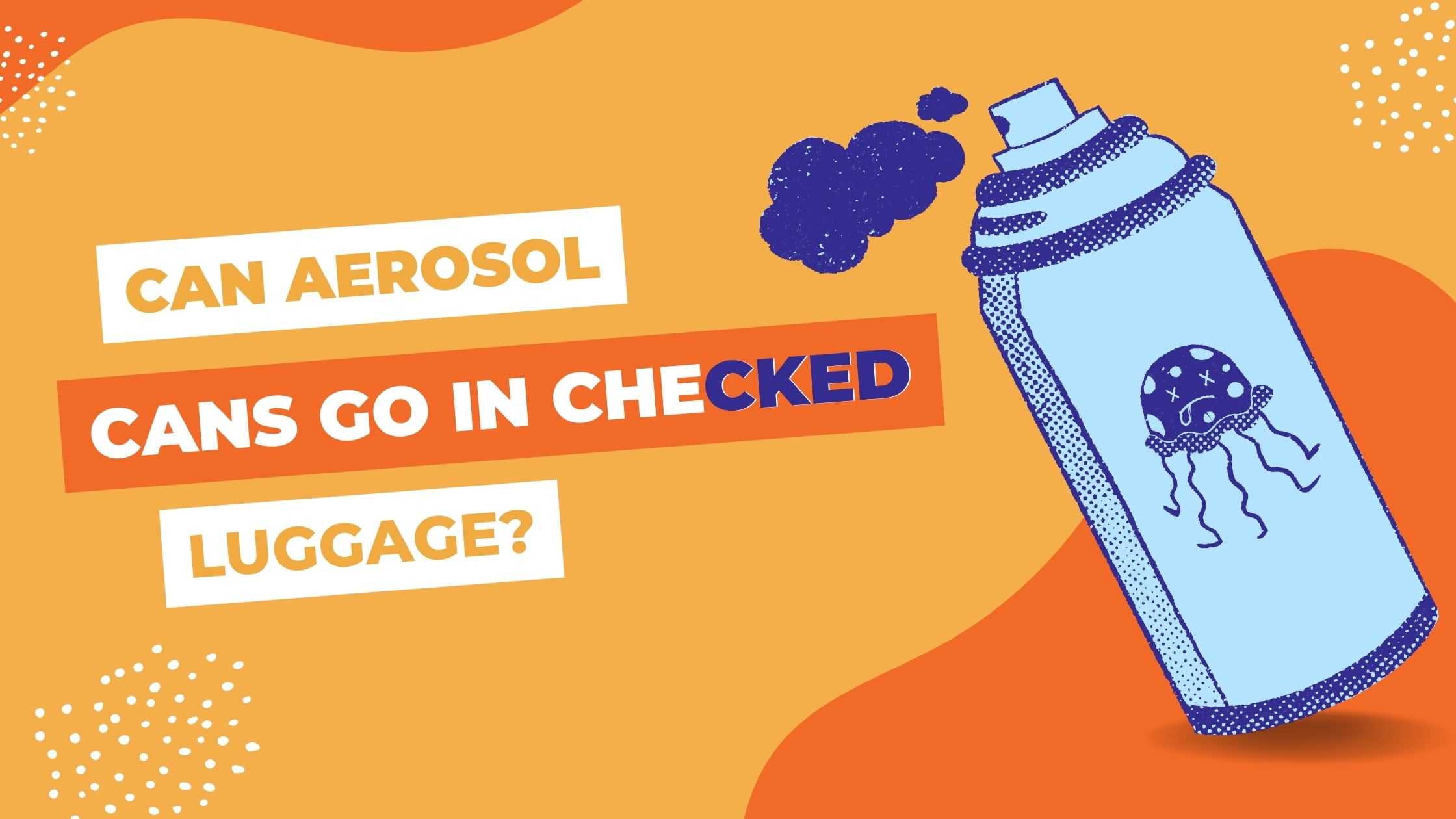Are you planning a trip and wondering “Can aerosol cans go in checked luggage?” or “you can pack your favorite hairspray or sunscreen in your checked luggage?” It’s a common question that many travelers ask, and for good reason.
In this article, we’ll explore and resolve your queries, regarding aerosol cans and provide you with the information you need to travel safely and confidently.
Can You Bring Aerosol Cans On A Plane?
Traveling with aerosol cans can be very convenient, but it’s important to know the restrictions and guidelines before you take your trip. According to the Transportation Security Administration (TSA), aerosol cans are allowed in both checked baggage and carry-on bags, as long as certain requirements are met.
For carry-on luggage, aerosol cans must be less than 3.4 ounces (100 milliliters) in size and placed in a clear, sealable plastic bag with other liquids and gels.
Each passenger is only allowed one quart-sized bag of liquids, aerosols, gels, creams, and pastes that fit comfortably within the bag.
If the container is larger than 3.4 ounces (100 milliliters), it must be placed in checked luggage.
For checked baggage, aerosol cans should be securely packaged and labeled.
Any leaking containers should not be packed in checked baggage and must instead be placed in carry-on bags.

Photo by Cullan Smith on Unsplash
Additionally, all aerosols containing flammable contents are prohibited from both types of luggage.
By following the guidelines set by the TSA, you can travel safely with your aerosol cans without having to worry about any potential issues at security checkpoints.
So whether you’re carrying them on or checking them into your bag, make sure to keep these restrictions and guidelines in mind before you board your flight!
Can Aerosol Cans Go In Checked Luggage?
Aerosol cans are allowed in checked luggage, but there are a few restrictions that you should be aware of. Federal Aviation Administration (FAA) says that the total amount of aerosols, that you can bring in your checked baggage cannot exceed 2 kg (70 ounces) or 2 L (68 fluid ounces).
On top of this, each container must not exceed 0.5 kg (18 ounces) or 500 ml (17 fluid ounces).
To ensure safety, it’s important for aerosol release devices such as buttons/nozzles to be protected by caps or other suitable means to prevent accidental release.
You’re also allowed to bring aerosol cans in carry-on bags as long as they meet the size and quantity restrictions.
If you have any questions or are unsure of what is allowed in your checked baggage, please contact your airline or local airport authority for more information.
Their policies can change frequently, so it’s important to make sure you’re up to date on the latest regulations.
With a little bit of planning and preparation, you can be sure that your aerosol cans will arrive safely in your checked luggage!
Is It Safe To Fly With Aerosol Cans?
Flying with aerosol cans can be safe as long as you take certain precautions and follow the rules and regulations set by the airline and the TSA. However, there is always a risk that aerosol cans can explode or rupture due to changes in temperature and pressure during air travel.
To ensure your safety while flying with aerosol cans, here are some tips to keep in mind:
- Pack Aerosols in Your Carry-On Bag: The best way to reduce the risk of an aerosol can exploding or rupturing is to pack them in your carry-on bag rather than checked luggage, as cargo holds of planes experience extreme changes in temperature and pressure which can cause an aerosol can to explode or rupture.
- Make Sure Your Aerosol are Sealed: Always make sure your aerosol cans are securely sealed and the lids are firmly in place to prevent any leakage or loss of pressure during air travel.
- Pay Attention to Label Instructions: Make sure you adhere to the instructions listed on each aerosol can’s label, such as not storing them near an open flame, keeping them away from direct sunlight, and avoiding temperatures above 120 degrees Fahrenheit (49 Celsius).
- Check with Your Airline: Before flying with aerosols, it is important to check with your airline for their specific guidelines about carrying aerosol cans onboard. Airlines may have restrictions in terms of the number and types of aerosol cans that can be carried on a flight.
- Store Aerosol Cans Safely: If you are packing your aerosol cans in checked luggage, make sure to store them safely to avoid any damage or leaks. It is best to place the containers inside sealed plastic bags and wrap them securely with bubble wrap for extra protection.
- Label Aerosols as Dangerous Goods: If you need to transport hazardous materials, such as flammable aerosol cans, it is important to follow all regulations set by the airline and label them accordingly so they will not be mistaken for regular items during security screening.
Overall, flying with aerosol cans can be safe as long as you take the necessary precautions and follow the rules and regulations set by the airline and TSA.
Is It Safe To Take Aerosol Cans In Checked Luggage?
Aerosol cans are considered hazardous materials by the US Department of Transportation (DOT). Thus, they must adhere to certain restrictions and regulations set by the TSA. Moreover, they may be additional requirements that must be met in order for them to be transported safely.
To ensure a safe journey for your aerosol cans, it’s important to check with your chosen airline before packing any aerosol cans in your checked luggage.
Different airlines will have different rules and regulations related to transporting these items. Therefore, make sure you understand what these requirements are prior to traveling.
Additionally, many airlines will also require you to declare any hazardous materials before check-in. Hence, make sure you are aware of this and have the necessary paperwork.
Once your aerosol cans have been safely packed in checked luggage, it’s important to remember that they should be placed in an upright position for transportation.
As a general rule, aerosols should never be stored horizontally or upside-down as this can lead to leakage or other safety issues.
Additionally, some airlines will also require that aerosol cans be stored in a plastic bag or container inside the checked baggage in order to reduce the risk of explosion or fire during flight.
Therefore, if your airline has such a requirement it’s important to make sure you adhere to it when packing your checked luggage.
What Size Aerosol Can You Take On A Plane?

Photo by Piret Ilver on Unsplash
When packing for a flight, it’s important to know the size and quantity restrictions for aerosol containers. All aerosols must be 3.4 ounces or less in volume and all containers must fit inside one quart-sized clear plastic bag with a zip top.
To make sure that your aerosol can is compliant, check the label beforehand.
If you are unsure of the contents, do not pack it in your carry-on luggage as it may be confiscated at security.
Additionally, only one quart-sized bag containing liquid, gel, or aerosol items is allowed per passenger.
For convenient storage during travel, consider purchasing smaller bottles than usual or purchase refillable containers that you can use on multiple trips.
You should also remember to keep all liquids and gels in an easily accessible area for the TSA inspection.
Following these guidelines will help ensure that your travel experience is as smooth and stress-free as possible.
If you have any further questions about the size and quantity restrictions on aerosols, contact your airline or the Transportation Security Administration (TSA) for more information.
Keep in mind that regulations can change so it is best to stay informed before packing for a flight.
Will Aerosol Cans Explode In Checked Luggage?
The short answer is no, aerosol cans are not likely to explode while in checked luggage. Although there have been rare occurrences in which an aerosol can has exploded due to extreme heat such as a fire. In most cases, luggage-holding aerosol cans result in just a small leak.
It’s important to remember that the conditions inside a checked baggage compartment on an airplane differ vastly from those of daily life.
The Federal Aviation Administration did a test where they placed a lithium-ion battery next to an aerosol can and exposed them both to intense heat.

Photo by Ziv Paczy on Unsplash
Even under these extreme circumstances, the aerosol can fail to actually explode.
So if you’re traveling with an aerosol can don’t worry! It’s highly unlikely that it will explode in your checked luggage.
Hence, you can rest easy knowing that the chances of a disaster are extremely low.
Of course, it’s always important to follow safety guidelines to ensure a pleasant journey.
Therefore, as long as your aerosol cans are not exposed to extreme heat or pressure, they should remain intact when placed in your checked luggage for travel by airplane.
So go ahead and pack those hairsprays, deodorants, and insect sprays without fear – the odds of an explosion are slim!
How To Pack Aerosol Cans For Flying?
The first step when packing aerosol cans for flying is to check with the airline and federal regulations. Both have specific policies in place when it comes to what you can bring on a plane, including aerosol cans when flying.
Once you’ve confirmed that your chosen brand of aerosol can is approved for travel, there are a few important points to keep in mind:
- Pack your aerosol cans upright – This will ensure that the pressurized container maintains its intended shape even during turbulence and altitude changes.
- When possible, use an airtight container or bag to store them – Some airlines may require this so be sure to double-check before boarding. This will not only prevent any potential leaks but also help to protect the can from damage or detonation due to sudden pressure changes.
- If you’re bringing more than one aerosol can with you, be sure that they are not touching each other directly – This could lead to a dangerous reaction between the two containers.
- Label your container containing aerosol cans as “Flammable” or “Hazardous Material” – This will alert airport personnel of its contents and will ensure that it is handled with extra care at all times.
- Store aerosol cans in a cool and dry place – Keep them away from direct sunlight or heat. It prevents them from overheating and rupturing suddenly during transportation.
By following these tips, you can safely pack and transport aerosol cans for flying.
What Kind Of Aerosols Are Not Allowed On Planes In Checked Luggage?
All flammable aerosols are completely prohibited from both carry-on bags and checked luggage. This includes spray paint, cooking spray, WD-40, aerosol laundry products, and all insecticides except those that are applied directly to the skin. If these items are discovered in your baggage, you may face charges.
However, not all aerosols are entirely forbidden from travel; non-flammable aerosols can be carried in both checked luggage and carry-on.
Examples of non-flammable aerosols include certain electrical cleaners, silicone sprays, and some air fresheners.
If you’re not sure if something is non-flammable or otherwise hazardous, it’s best to research the item thoroughly or simply leave it at home.
It’s important to remember that following TSA guidelines can help make your travel experience much smoother and more enjoyable.
Please take a moment to review the list of prohibited items before packing your bag so that you avoid any inconvenience while going through security checkpoints.
| Aerosol Type | Carry On Luggage | Checked Luggage |
| Hair Spray | Yes | Yes |
| Dry Shampoo | Yes | Yes |
| Perfumes | Yes | Yes |
| Shaving Foam, Or Cream | Yes | Yes |
| Spray Paint | No | No |
| Body spray | Yes | Yes |
| After Shave | Yes | Yes |
| Lysol Spray | No | No |
| Spray Paint | No | No |
| Pepper Spray | No | Yes(with restrictions) |
| Antiperspirant | Yes | Yes |
| WD 40 | No | No |
| Spray Starch | No | No |
| Suntan Lotion | Yes | Yes |
| Insect Repellent Sprays | No | No |
With proper planning and due diligence, you will be able to have a safe and hassle-free journey!
FAQs
Are There Any Other Restrictions Or Guidelines You Should Be Aware Of When Packing Aerosol Cans In My Luggage?
The Transportation Security Administration (TSA) prohibits the transportation of any flammable or hazardous aerosol cans in either carry-on bags or checked luggage. This includes spray paint, cooking spray, WD-40, and all insecticides except those that are applied directly to the skin.
If you violate this rule, you could face a hefty fine and even jail time.
However, some non-flammable aerosol products are permitted in checked luggage only.
Examples of non-flammable aerosols include certain electrical contact cleaners, air dusters, and carbon dioxide cartridges for recreational activities such as paintballing and airsoft guns.
It is important to note that even non-flammable aerosols must not exceed the limits of 3.4oz (or 100ml) per item for each container or package. Furthermore, it should be packed in the original retail packaging when possible.
Can You Bring Aerosol Cans On An Airplane?
Yes, you can bring aerosol cans on an airplane. When packing aerosol cans in your checked luggage, it’s important to make sure the container is secure and not easily accessible. You should also be aware that some aerosols contain pressurized gases or flammable liquids are restricted.
It’s best to check with your airline before you travel to find out what types of items are prohibited from being transported in your checked luggage.
Also, if you have any medication that requires an inhaler, there are usually special rules for those as well.
For example, most U.S. airlines allow passengers to carry up to two small inhalers (with no more than one canister each) onto the airplane in their personal item bag or purse.
However, many airlines require passengers to have a letter from their doctor confirming that the inhaler is medically necessary.
Can You Bring Aerosol Sunscreen On A Plane?
The answer is yes—you can generally bring aerosol sunscreen in both your carry-on and checked baggage. However, the aerosol sunscreen canisters should not exceed 3.4 ounces (100 milliliters) in size. It must be placed inside a clear, plastic bag that is quart-sized.
It would hold all of your liquids, gels, and aerosols together when going through security screening.
The clear plastic bag should be removed from your luggage and placed in a separate bin during the security process.
How Do You Pack Aerosol Hairspray In Checked Luggage?
Choose a sturdy and leak-proof container, then wrap the can in a protective material such as bubble wrap or foam. Place the can into the container, fill any empty space with packing peanuts or paper towels, and seal it tightly.
Mark the package clearly with ‘Aerosol Hairspray’ so that airline staff is aware of the contents.
Place your packed aerosol hairspray in your checked luggage to ensure that it is not subject to any temperature changes during its journey.
Make sure you inspect your aerosol can prior to flying. If there are any signs of damage, do not use it on board an aircraft for safety reasons.
Following these steps will help protect your aerosol hairspray from being damaged during travel.
Conclusion
In conclusion, aerosol cans can go in checked luggage, but there are important considerations and precautions to take to ensure that they are packed safely and securely.
It’s always a good idea to check with your airline’s specific rules and regulations on packing aerosol cans, especially if you are unsure.
Remember that packing aerosol cans in your carry-on bag is generally safer than in checked luggage.
By following these guidelines and taking the necessary precautions, you can safely and confidently pack your aerosol cans for your next trip.







